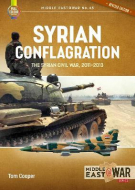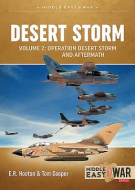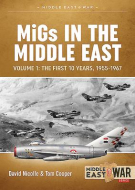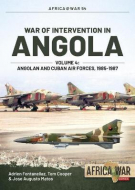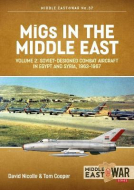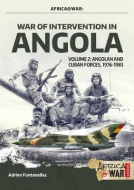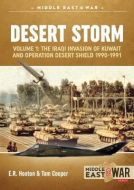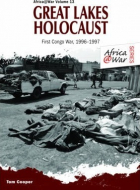
- Agriculture
- Architecture & Design
- Arts & Photography
- Biography
- Business
- Calendars and Diaries
- Childrens (All)
- Childrens (Illustrated)
- Childrens (Picture flats)
- Childrens (Te Reo)
- Classics
- Cooking, Food & Drink
- Craft & Hobbies
- Design (Art / Graphics)
- Design (Interiors)
- Education
- Fashion
- Fiction & Literature
- Fiction - Young Adult
- Gift Ideas
- Health & Wellbeing
- History
- Home & Garden
- Humour & Gift
- Instead of a Card Poems
- Military
- Music
- New Zealand
- NZ (History)
- NZ (Landscapes)
- NZ (Pictorial)
- Poetry
- Reference
- Religion & Faith
- Science & Nature
- Sport & Recreation
- Stationery
- Taschen : 40th Anniversary Edition
- Taschen : BA Basic Art
- Taschen : BU Bibliotheca Universalis
- Te Reo Māori
- Transport
- Travel
Tom Cooper (34)
|
Syrian Conflagration: Revised Edition (Middle East@War 45)
ISBN: 9781915070814 Author: Tom Cooper Publisher: Helion & Company The Syrian Civil War experienced an entirely unexpected transformation during its first two years. It started as unrest and a series of mass demonstrations with... The Syrian Civil War experienced an entirely unexpected transformation during its first two years. It started as unrest and a series of mass demonstrations within the Syrian population in the context of wider protest movements in the Middle East and North Africa in 2011, known as the Arab Spring. Unlike events in Egypt, Libya, Tunisia and Yemen, where oppressive governments were toppled by the end of that year, the government of Syria deployed the full force of its military, its intelligence apparatus, and paramilitary groups, launching an unprecedented crackdown that resulted in the arrest, detention and killing of many thousands. Despite its brutality, this effort backfired: it provoked mass desertions of the Syrian military and then an armed uprising. The emerging insurgency was generally successful through 2012, although failing to capture Damascus, it secured more than half of Aleppo and Homs, the provincial capital of Raqqa, and nearly all of north-eastern and north-western Syria under its control. Although propped-up by economic and military support from the Islamic Republic of Iran and the Russian Federation, the government of Syria was nearing the brink of collapse during the first half of 2013 when, prompted by Tehran, Hezbollah - a Shi'a Islamic militant group and political party from Lebanon - entered the conflict on its side. Soon after, Hezbollah was reinforced by significant contingents of Iranian-sponsored Shi'a from Iraq, Lebanon and elsewhere, followed by volunteers from Iran, including crack units of the Islamic Revolutionary Guards Corps. Meanwhile, already split along the lines of Syria's complex demography, much of the insurgency transformed from a secular and non-sectarian movement into proxies of various foreign powers, foremost Saudi Arabia and Qatar, but also Turkey and Kuwait. Furthermore, foreign Jihadists motivated by al-Qaida joined the fray, aiming to establish an Islamist state and clandestinely cooperating with the government, they fell upon the insurgency. Bind: paperback Pages: 96 Dimensions: 210 x 297 mm Publication Date: 20-06-2022 |
$49.99 |
|
|
Operation Desert Storm: Volume 2 (Middle East@War 31)
ISBN: 9781913336356 Authors: Tom Cooper, Ted Hooton Publisher: Helion & Company Early in the morning of 2 August 1990, aircraft of the Iraqi Air Force bombed Kuwaiti air bases, and then the Iraqi Republican Guards stormed into the country. ... Early in the morning of 2 August 1990, aircraft of the Iraqi Air Force bombed Kuwaiti air bases, and then the Iraqi Republican Guards stormed into the country. Thus began what would be called the 'Gulf War' - or the 'II Gulf War' or 'II Persian Gulf War' - fought between January and March 1991. Although encountering some problems, the Iraqi forces occupied Kuwait in a matter of a few days. However, when President Saddam Hussein of Iraq unleashed his military upon Kuwait, little did he know what kind of reaction he would provoke from the Western superpowers, and what kind of devastation his country would suffer in return. Concerned about the possibility of Iraq continuing its advance into Saudi Arabia, the USA - in coordination with Great Britain, France, and several local allies - reacted by deploying large contingents of their air, land and naval forces to the Middle East. Months of fruitless negotiations and the continuous military buildup - Operation Desert Shield - followed, as tensions continued to increase. Determined to retain Kuwait, and despite multiple warnings from his own generals, Saddam Hussein rejected all demands to withdraw. The USA and its allies, 'the Coalition', were equally as determined to drive out the invader and restore Kuwaiti independence. Gradually, they agreed this would have to be by force. Following an authorization from the United Nations, the Coalition launched the Operation Desert Storm, on 17 January 1991, opening one of the most intensive air campaigns in history. The last conventional war of the 20th Century saw the large, but essentially traditional, Iraqi Army overwhelmed by forces trained and equipped to exploit the latest technologies. Bind: paperback Pages: 72 Dimensions: 210 x 297 mm Publication Date: 17-02-2021 |
$49.99 |
|
|
MiGs in the Middle East: Volume 1 (Middle East@War 33)
ISBN: 9781913336363 Authors: David Nicolle, Tom Cooper Publisher: Helion & Company Egypt and Czechoslovakia signed the so-called 'Czechoslovak Arms Deal', thus initiating a unique era of close cooperation between major Arab military powers, th... Egypt and Czechoslovakia signed the so-called 'Czechoslovak Arms Deal', thus initiating a unique era of close cooperation between major Arab military powers, the former Union of the Soviet Socialist Republics (USSR) and its allies. During the first decade of this period, the air force of Egypt, followed by those of (in chronological order) Syria, Iraq, Morocco and Algeria, were all equipped with dozens and then hundreds of Soviet-made fighters designed by the Mikoyan I Gurevich Design Bureau - the same swept-wing jets that took the Western powers by surprise during the Korean War. While the first generation of MiG jet fighter - the MiG-15 - saw only a relatively brief service in Egypt, its more efficient and upgraded successor, the MiG-17F, entered service in bigger numbers, and then formed the backbone of additional air forces around the Middle East. The MiG-17PF became the first radar-equipped combat aircraft while the MiG-19 became the first supersonic fighter flown by the air forces of Egypt and Iraq, in the period 1958-1963. In Morocco and Algeria, the MiG-17 was the first and the only jet fighter in service during the first half of the 1960s. Unsurprisingly, MiG-15s, MiG-17s and MiG-19s thus served with many different units and - especially in Egypt and Algeria, and also in Syria - wore a wide range of very different, and often very colorful unit insignia and other markings. They were also flown by many pilots who subsequently played crucial roles in the future of their nations. Based on original documentation and extensive interviews with veterans, and richly illustrated, MiGs in the Middle East, Volume 1 is a unique source of reference on the operational history of MiG-15, MiG-17, and MiG-19 fighter jets in Algeria, Egypt, Iraq, Morocco, and Syria from 1955 until 1956. This is the first volume in a mini-series. Bind: paperback Pages: 72 Dimensions: 210 x 297 mm Publication Date: 28-04-2021 |
$49.99 |
|
|
War of Intervention in Angola: Volume 4 (Africa@War 54)
ISBN: 9781914059254 Authors: Adrien Fontanellaz, Tom Cooper, Jose Matos Publisher: Helion & Company War of Intervention in Angola, Volume 4 continues the coverage of the operational history of the Angolan Air Force and Air Defence Force (FAPA/DAA) as told by A... War of Intervention in Angola, Volume 4 continues the coverage of the operational history of the Angolan Air Force and Air Defence Force (FAPA/DAA) as told by Angolan and Cuban sources, in the period 1985-1988. Many accounts of this conflict - better known in the West as the 'Border War' or the 'Bush War', as named by its South African participants - consider the operations of the FAPA/DAA barely worth commentary. At most, they mention a few air combats involving Mirage F.1 interceptors of the South African Air Force (SAAF) in 1987 and 1988, and perhaps a little about the activity of the FAPA/DAA's MiG-23s. However, a closer study of Angolan and Cuban sources reveals an entirely different image of the air war over Angola in the 1980s: indeed, it reveals the extent to which the flow of the entire war was dictated by the availability - or the lack - of air power. These issues strongly influenced the planning and conduct of operations by the commanders of the Angolan and Cuban forces. Based on extensive research with the help of Angolan and Cuban sources, War of Intervention in Angola, Volume 4, traces the Angolan and Cuban application of air power between 1985-1988 - during which it came of age - and the capabilities, intentions, and the combat operations of the air forces. The volume is illustrated with 100 rarely seen photographs, half a dozen maps and 15 color profiles, and provides a unique source of reference on this subject. Bind: paperback Pages: 80 Dimensions: 210 x 297 mm Publication Date: 15-07-2021 |
$49.99 |
|
|
MiGs in the Middle East: Volume 2 (Middle East@War 37)
ISBN: 9781914059360 Authors: David Nicolle, Tom Cooper Publisher: Helion & Company Hundreds of fighter-bombers of Soviet design and manufacture served in the air forces of multiple frontline Arab states during the first half of the 1960s. Not ... Hundreds of fighter-bombers of Soviet design and manufacture served in the air forces of multiple frontline Arab states during the first half of the 1960s. Not only older Mikoyan i Gurevich MiG-15s and MiG-17s, but also newer types such as the MiG-19 and MiG-21 were acquired in continuously increasing numbers, concurrently with Ilyushin Il-28- and Tupolev Tu-16 bombers, transport types such as the Antonov An-12 and Ilyushin Il-14, and trainers designed by Yakovlev. Nowhere else did they - and their pilots - play as important a role for the future of the local air forces - or entire nations - as in Egypt and Syria from 1963 until 1967. Whilst the period in question is still frequently described as a 'peaceful decade' in Israel and the West, they saw almost uninterrupted action: in Egypt, in Syria, as well as in Yemen, and especially in continuous incidents with Israel. Based on official documentation and extensive interviews with dozens of veterans, and richly illustrated with exclusive photography and color profiles, MiGs in the Middle East Volume 2 is a uniquely compact yet comprehensive guide to the build-up and operational history of Soviet-made aircraft in Egypt and Syria during this period. Prepared by authors that have established themselves as top authorities on the Arab air forces, and supported by custom-drawn color profiles and detailed maps, it provides an exclusive, in-depth study and a single point of reference for the operational history of the Egyptian and Syrian air forces, their organization and markings of the mid-1960s. Bind: paperback Pages: 80 Dimensions: 210 x 297 mm Publication Date: 01-09-2021 |
$49.99 |
|
|
Lebanese Civil War (Middle East@War 41)
ISBN: 9781914377150 Authors: Tom Cooper, Sérgio Santana Publisher: Helion & Company Once known as the 'Switzerland of the Middle East', an island of economic stability and social progress, Lebanon was shattered by a civil war that raged from 19... Once known as the 'Switzerland of the Middle East', an island of economic stability and social progress, Lebanon was shattered by a civil war that raged from 1975 until 1990. While Volume 1 of this mini-series concentrated on the conflict pitting the central government against different factions and alliances of Christians, Sunni and Shi'a Moslems, leftists, and the Israeli and Syrian armed forces from its beginning in 1975 until the Israeli Operation Stone of Wisdom (or Operation Litani) in 1978, Volume 2 continues with the period from 1978 until 1981. With its armed forces of a size comparable to that of the strength of the active components of the contemporary US Army and led by politicians pursuing aggressive intentions towards its northern neighbor, Israel gradually established itself in control over much of southern Lebanon and all of Lebanese airspace. In turn, Syria found itself facing not only a growing insurgency and unrest at home, but also strong opposition inside Lebanon. Moreover, a seemingly endless series of air battles with the Israeli air force exposed a growing technological gap with its primary opponent, forcing it to deploy ever larger contingents of its air defenses into Lebanon. After almost culminating in a major war in 1981, the situation was defused through international pressure: nominally at least, a relatively quiet period was to follow before the next storm. Focusing on military-related developments, and containing much exclusive detail and specially commissioned illustrations, Volume 2 of Lebanese Civil War dissects the military forces of Israel, Syria and the many Lebanese militias, their equipment, intentions and capabilities, and provides a detailed, blow-by-blow account of combat operations into 1981. Bind: paperback Pages: 82 Dimensions: 210 x 297 mm Publication Date: 28-02-2022 |
$49.99 |
|
|
War of Intervention In Angola Volume 2 (Africa@War 34)
ISBN: 9781911628651 Authors: Adrien Fontanellaz, Tom Cooper Publisher: Helion & Company As of mid-1976, the civil war in Angola was seemingly decided: supported by a large contingent of Cuban forces, the MPLA established itself in power in Luanda. ... As of mid-1976, the civil war in Angola was seemingly decided: supported by a large contingent of Cuban forces, the MPLA established itself in power in Luanda. Its native competitors, the US-French-Zaire-supported FNLA, and UNITA, supported by China and South Africa, were in tatters. The French and Zaire-supported FLEC - an armed movement for the independence of the oil-rich Cabinda enclave - was in disarray. The last few of their surviving units were either driven out of the country, or forced into hiding in isolated corners of northern and southeastern Angola. Nevertheless, the war went on. The MPLA's government failed to decisively defeat UNITA, in southern Angola, and then found itself facing a coup attempt from within in May 1977. Crushed in blood, this resulted in thousands being jailed and tortured: many more escaped abroad, where they reinforced the ranks of the battered opposition. The coup prompted the Soviets to attempt increasing their influence with the aim of establishing permanent military bases in the country. While all such overtures were turned down, Angolan operations along the border to what was then the South-West Africa (subsequently Namibia) in October 1980, combined with the increased activity of SWAPO - an insurgency against the South African control of that territory - subsequently Namibia - prompted South Africa to launch another military intervention and resume supporting UNITA. In turn, this prompted not only the Cubans to further increase their military presence, but also the Soviet Union into delivering massive amounts of military aid to the government in Luanda. Angola not only assumed the role of one of the major hot battlefields in the Cold War: its 'civil war' saw a number of major showdowns between diverse belligerents, culminating in the Battle of Cangamba in 1983. Based on extensive research, with help of Angolan and Cuban sources, War of Intervention in Angola, Volume 2 traces the military build-up of the Cuban and Soviet-supported Angolan military, the FAPLA and its combat operations, and those of the Cuban military in Angola, in the period 1976-1983, their capabilities and intentions, and their battlefield performances. The volume is illustrated with over 100 rare photographs, half a dozen maps and 18 color profiles. Bind: paperback Pages: 80 Dimensions: 210 x 300 mm Publication Date: 11-07-2019 |
$49.99 |
|
|
Desert Storm Volume 1 (Middle East@War 18)
ISBN: 9781911628224 Authors: E R Hooton, Tom Cooper Publisher: Helion & Company Early in the morning of 2 August 1990, aircraft of the Iraqi Air Force bombed Kuwaiti air bases, and then the Iraqi Republican Guards stormed into the country. ... Early in the morning of 2 August 1990, aircraft of the Iraqi Air Force bombed Kuwaiti air bases, and then the Iraqi Republican Guards stormed into the country. Thus began what would be called the 'Gulf War' - also the 'II Gulf War', and sometimes the 'II Persian Gulf War' - fought between January and March 1991. Although encountering some problems, the Iraqi forces occupied Kuwait in a matter of few days. However, when President Saddam Hussein of Iraq unleashed his military upon Kuwait, little did he know what kind of reaction he would provoke from the Western superpowers, and what kind of devastation his country would suffer in return. Concerned about the possibility of Iraq continuing its advance into Saudi Arabia, the USA - in coordination with Great Britain, France, and several local allies - reacted by deploying large contingents of their air, land, and naval forces to the Middle East. Months of fruitless negotiations and the continuous military buildup - Operation Desert Shield - followed, as tensions continued to increase. Determined to retain Kuwait, and despite multiple warnings from his own generals, Saddam Hussein rejected all demands to withdraw. The USA and its allies, 'the Coalition', were as determined to drive out the invader and restore Kuwaiti independence. Gradually, they agreed this would have to be by force. Following an authorization from the United Nations, the Coalition launched Operation Desert Storm, on 17 January 1991, opening one of the most intensive air campaigns in history. The last conventional war of the 20th Century saw the large, but essentially traditional, Iraqi Army overwhelmed by forces trained and equipped to exploit the latest technologies. Desert Storm reveals the whole war fought between Iraq and an international coalition, from the start of this campaign to its very end. Largely based on data released from official archives, spiced with numerous interviews, and illustrated with over 100 photographs, 18 color profiles and maps, it offers a refreshing insight into this unique conflict. Bind: paperback Pages: 112 Dimensions: 210 x 300 mm Publication Date: 13-08-2019 |
$49.99 |
|
|
Great Lakes Holocaust (Africa@War 13)
ISBN: 9781909384651 Author: Tom Cooper Publisher: Helion & Company Great Lakes Holocaust' is the first in two volumes covering military operations in Zaire - as the Congo was named from 1971 until 1997 - and the Democratic Repu... Great Lakes Holocaust' is the first in two volumes covering military operations in Zaire - as the Congo was named from 1971 until 1997 - and the Democratic Republic of Congo at the turn of the 21st century. This volume explores the events of the 1980s and 1990s in Rwanda and Uganda, which eventually spilled over the borders into Zaire, resulting in one of the worst tragedies ever to befall an African region. The narrative traces the ascent of crucial Rwandan, Congolese and Ugandan military and political figures, and their connections within influential business and political circles in and outside Africa. It examines the build-up of the Zairian military under the government of Dictator Mobutu Sese Seko in the 1960s and 1970s, and provides an in-depth study into reasons for its near-collapse in the early 1990s. The military build-up of Rwanda and Uganda is discussed in detail as is their planning for operations inside Zaire, and the global logistic tail that provided the Rwandan military, particularly, but also most of its opponents, with a capability of not only waging war beyond their borders, but - in the case of Rwanda - of invading and practically conquering a country the size of Western Europe or the USA east of the Mississippi. The book further traces the covert Rwandan military actions inside Zaire, initially run under the guise of an insurgency by one of Zaire's ethnic minorities; how ever-deepening Rwandan operations inside Zaire were practically dictated by concentrations of Hutu refugees; and how the insurgency - led by Laurent-Désiré Kabila who was installed by key Rwandan and Ugandan military and political figures - developed into an organization that sought autonomy from the military and political dictates of Rwanda, in turn delivering a direct reason for the Second Congo War which was fought from 1998-2003. Bind: paperback Pages: 72 Dimensions: 210 x 300 mm Publication Date: 19-11-2013 |
$49.99 |
|
|
Great Lakes Conflagration (Africa@War 14)
ISBN: 9781909384668 Author: Tom Cooper Publisher: Helion & Company Great Lakes Conflagration' is the second in two volumes covering military operations in the Democratic Republic of Congo (DRC) at the turn from the 21st century... Great Lakes Conflagration' is the second in two volumes covering military operations in the Democratic Republic of Congo (DRC) at the turn from the 21st century. This volume explores developments in the DRC that led to the outbreak of violence in August 1998, and systematically details the continued build-up and status of the Congolese, Rwandan and Ugandan armies, as well as the forces of Angola, Namibia, Zimbabwe and other African countries that were sucked into the conflict. Recounted is the Rwandan attempt to topple the government of Laurent Kabila through an operation that saw a redeployment of some of best Rwandan units from Kigali and Goma to the western DRC, resulting in a series of fierce air-land clashes with Zimbabwean and Angolan forces and culminating in the Battle of Kinshasa. Also described is the fighting along what became the 'Eastern Front' in the DRC, as Zimbabwean and allied troops attempted to stop Rwandan, Ugandan and rebel advances out of Kivu Province in the direction of the Congo River through 1998 and 1999. These early phases of the war, or 'The First African War' as it has come to be known, were characterized by surprising outflanking and infiltration maneuvers; foreign mercenaries; Zimbabwean Hawk and Lynx light strikers flying intensive combat operations from N'Djili airport, half of which was occupied by Rwandans, Ugandans and Congolese rebels; interdiction strikes guided by special forces deployed deep behind enemy lines; operations of helicopter gunships and transport aircraft under intense ground attack in support of troops cut off by advancing opponents; use of transport aircraft as makeshift bombers in bad weather and by night and clashes of armored forces and many other elements of 'high-technology' warfare. All the protagonists deployed their best military units, their best equipment and some of their best military commanders, yet despite their best efforts, and hampered by in-fighting, the conflict ultimately resulted in a stalemate which dragged on for a further three years while negotiations bogged down. This book is illustrated with an extensive selection of exclusive photography, color profiles and markings, making it of special interest to enthusiasts and professionals alike. Bind: paperback Pages: 72 Dimensions: 210 x 300 mm Publication Date: 19-11-2013 |
$49.99 |


